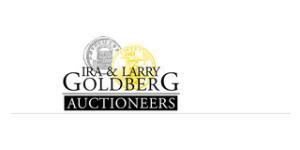1 Dollar (Verkauft für $37500.0)
1795 B-6, BB-25 Flowing Hair 3 Leaves Missing Leaf Rarity 8. PCGS graded EF-45. Subset of PCGS # 6852. In a new secure plus holder. Condition Census. Attractive prooflike surfaces. Pop 1; none finer at PCGS for the variety. The only example graded at PCGS of this intriguing variety. Please compare areas that are boxed on the reverse of the regular BB-25 and the missing leaf BB-25. Flowing hair in six curls, 3rd and 4th close together; lowest curl barely misses a point of first star, but continues on to touch and slightly pass a second point of same star. The second curl from bottom turns downward pointing to space between two points of second star. Wide date, 79 closest. E in LIBERTY punched over an earlier erroneous R. The Y in LIBERTY is higher than the adjacent T. Foot of R in LIBERTY shortened from a broken punch. Obverse die used to strike 1795 BB-24 (early state) and BB-25 (early and late states). Three leaves under each wing of eagle. 13 berries, seven on left branch, six on right. Two berries under first T in STATES, one on inside and one on outside of wreath. Die State I has three leaves visible below first S of STATES. Die State III with four leaves; also used in its later state to coin BB-26 and BB-27, each of which has four leaves beneath the first S of STATES. Reverse die used to strike 1795 BB-25 (two states; Die State I with three leaves and Die State III with four leaves under first S in STATES), BB-26 (later state with four leaves under first S in STATES), and BB-27 (later state with four leaves under first S in STATES). Die State I: Two specimens are known to the writer. The first is Frank M. Stirling's discovery piece, which from the illustration in The Numismatist appears to be EF. The second is that included in Stack's sale of the Spies Collection, December 9-10, 1974, Lot 19, and described as prooflike EF, with a few faint scratches between the 1 and 7 of the date. Die State II: Transitional state. Not seen by the author. Die State III: It is believed that 201 to 500 specimens of 1795 BB-25, Die State III, exist, most of which are in lower grades through VF. The rims are usually indistinct in portions, with some areas appearing flattened; weakness is usually seen at the rim beginning about the 8th star and continuing over LIBE, and from the 13th star, the date, to the 1st or 2nd star; on the reverse, the weakness is most often seen at the rim above UNI and OF AME. Most specimens are weak at the obverse center in the area of Miss Liberty's ear (which is usually not visible), and on the eagle's breast. In the opinion of Early Dollar expert Martin Logies, the re-working of the reverse die following this early die state is so extensive that the "Die State I" examples should be recognized as a separate die variety. This is the discovery coin made by Frank Stirling in 1952. At the time it was given a separate Bolender number 18 but then was found to be a die state of B-6. Now this is where it gets tricky. The three leaf or missing leaf is located on the reverse under the first S in STATES! This reverse A was used for only a short time - ONLY TWO SPECIMENS HAVE BEEN FOUND - the original Stirling specimen and the Spies's specimen sold in 1976 which has never been seen since! The Missing Leaf was called this because it was once believed that the common 4 leaf variety was struck with some material plugged in the fourth leaf making it disappear (see Bowers and Borckardt's Book). This is NOT TRUE as noted in the July 2007 issue of the, "Rare Coin Market Report" where John Dannreuther goes through the sequence of die varieties used! The Missing Leaf was the first use of the obverse and reverse followed by use in the B-13, BB-24 (Obverse used but with significant changes in the DATE, especially 795); B-12, BB-26 (Reverse B used now with an added 4th leaf under first S in STATES); B-5, BB-27 (same 4 leaf Reverse B); and THEN back to the B-6, BB-25 but with the reworked Obverse and the added 4th leaf Reverse B. So does this make it a different variety? I say it does! PCGS even gave it a different #148300 as oppose to the usual B-6, BB-25 #39975! Rarity 8. The finest of the two known and the Frank Stirling Discovery Coin. Estimated Value $75,000 - 85,000. The Dr. Hesselgesser Collection. Categories: Draped Bust Dollars, Half Dollars
Mehr...
Preis

|
Beigetragen von:
anonymous 2015-03-02 |
|
||
|
||
|
||
Sie sind vielleicht an folgenden Münzen interessiert
2024-04-24
- New coin is added to 1/2 Thaler Salzburg Silber
1/2 Thaler Salzburg Silber
Diese Gruppe hat 16 Münzen / 12 Preise
⇑
1694, Salzburg, Johann Ernst von Thun. Beautiful Silver ½ Thaler Coin. NGC UNC+
Mint Year: 1694
Denomination: 1/2 Thaler
Reference: Probszt 1817, KM-253.
Mint Place: Salzburg (as indep ...
2024-04-23
- New coin is added to 1 Lira Kingdom of Italy (1861-1946) Silber Vittorio Emanuele ...
1 Lira Kingdom of Italy (1861-1946) Silber Vittorio Emanuele ...
Diese Gruppe hat 8 Münzen / 6 Preise
⇑
Details about ITALY 1912R 2 Lire Silver XF
Das könnte Sie auch interessieren:

-600-300-eRsKbzbiRTgAAAFLo7qjltwu.jpg)

-300-150-yb4KbzbiSd4AAAFLiC2jltwv.jpg)
 English
English




-300-150-rb8Kbzbi55EAAAFLT93k0KhO.jpg)






